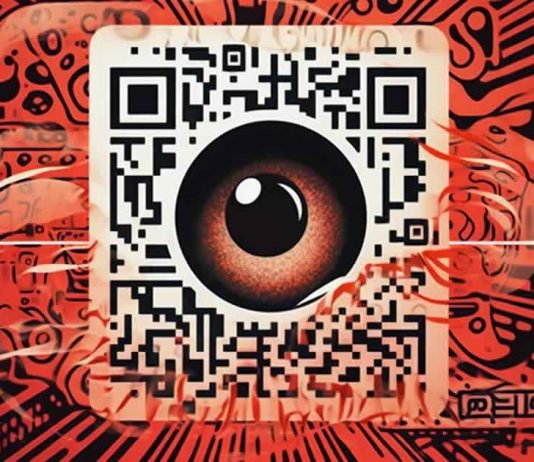In our constantly improving digital era, QR codes have emerged as a ubiquitous tool, seamlessly integrating into our daily lives. These black-and-white patterns provide a quick and efficient way to access information, make payments, and interact with businesses. However, ExpressVPN’s study shows that alongside their convenience, fraudsters have found innovative ways to exploit QR codes for their nefarious activities. This article delves into the depths of QR code exploitation, shedding light on the tactics employed by fraudsters and empowering readers with the knowledge to protect themselves from falling victim to these digital scams.
QR Codes: A Gateway to Convenience and Vulnerability
QR codes, short for Quick Response codes, are two-dimensional barcodes scanned using a smartphone camera or a dedicated scanning app. Their versatility and ease of use have propelled their adoption in various sectors, including retail, marketing, and ticketing. However, the very features that make QR codes popular—quick access to information and seamless transactions—also create vulnerabilities that fraudsters exploit. By understanding the potential risks associated with QR codes, users can securely arm themselves with the necessary precautions to navigate this digital landscape.
Unveiling the Tactics of QR Code Exploitation
Fake QR Codes:
Fraudsters create counterfeit QR codes that redirect users to malicious websites or apps designed to steal sensitive information.
Phishing Attacks:
Fraudsters leverage QR codes to lead unsuspecting users to fake login pages, capturing their credentials for unauthorized access.
Malware Distribution:
QR codes can be weaponized as a delivery mechanism for malware, infecting users’ devices and compromising their security.
Unauthorized Transactions:
Scammers exploit QR codes to initiate unauthorized payments, transferring funds from unsuspecting victims.
Social Engineering:
Fraudsters manipulate user trust by employing QR codes in schemes that extract personal information or initiate fraudulent activities.
Recognizing the Warning Signs
Suspicious URLs or domains:
Users should be wary of QR codes containing unfamiliar or suspicious web addresses.
Poorly designed or unusual QR codes:
Fraudsters often create QR codes that deviate from the norm regarding appearance or structure.
Unexpected or unsolicited QR codes:
Users should exercise caution when encountering QR codes sent via email, text messages, or social media from unknown sources.
Requests for personal or financial information:
QR codes should never prompt users to enter sensitive data without a legitimate and trustworthy reason.
Shielding Yourself from QR Code Scams
Use Trusted QR Code Scanning Apps:
Download reputable scanning apps from official app stores to ensure the authenticity and security of the scanning process.
Verify the Destination Before Scanning:
Double-check the URL or web address associated with the QR code to confirm its legitimacy before scanning.
Be Mindful of Personal Information:
Avoid providing unnecessary personal or financial details when prompted by QR codes, especially from unfamiliar sources.
Stay Updated with Security Measures:
Regularly update your smartphone’s operating system and scanning apps to benefit from the latest security patches and features.
Educate Yourself and Others:
Stay informed about QR code scams and share your knowledge with friends, family, and colleagues to collectively combat fraud.
Reporting QR Code Scams
Reporting to Local Authorities:
Notify local law enforcement agencies or cybercrime divisions about any incidents involving QR code scams.
Contacting the Business or Organization:
Inform the legitimate business or organization associated with the fraudulent QR code to alert them of the scam.
Reporting to Cybersecurity Agencies and Organizations:
Reach out to relevant cybersecurity agencies, consumer protection organizations, or antifraud bodies to report QR code scams and provide them with the necessary details for investigation and potential action.
Staying Vigilant: Best Practices for QR Code Safety
Scrutinize QR Codes:
Before scanning a QR code, examine it carefully for any signs of tampering or unusual elements.
Avoid Unknown Sources:
Only scan QR codes from trusted sources, such as reputable businesses, official websites, or verified marketing materials.
Check for HTTPS:
Ensure that the destination website or app indicated by the QR code has a secure HTTPS connection, denoted by a padlock symbol.
Use QR Code Generators Wisely:
If you are a business or organization generating QR codes, employ secure QR code generation platforms and safeguard the codes from unauthorized access.
Permit Two-Factor Verification:
Implementing two-factor confirmation is necessary; it is possible to enhance the security of your accounts and transactions.
Educating Employees and Customers
Employee Training:
Businesses should provide comprehensive training to their employees, educating them about QR code scams, their implications, and best practices for safe scanning.
Customer Awareness:
Companies should actively communicate with their customers, raising awareness about QR code fraud and offering guidance on how to avoid falling victim to scams.
Industry Collaboration and Regulation
Collaboration among Businesses:
Companies operating in various industries can collaborate to share information and insights on QR code scams, enabling a collective response against fraudsters.
Regulatory Measures:
Governments and regulatory bodies should establish guidelines and standards for QR code security, encouraging businesses to adopt best practices and ensuring the protection of consumer interests.
Conclusion:
QR codes have undeniably transformed the way we interact with the digital world, offering convenience and efficiency. However, it is crucial to remain vigilant and proactive in protecting ourselves from QR code exploitation. By understanding the tactics employed by fraudsters, recognizing warning signs, and implementing best practices for QR code safety, we can mitigate the risks and enjoy the benefits of this technology without compromising our security. Furthermore, we can collectively combat QR code scams and create a safer digital ecosystem through collaboration, education, and regulatory efforts. Stay informed, stay cautious, and protect yourself from the dark side of QR codes.
